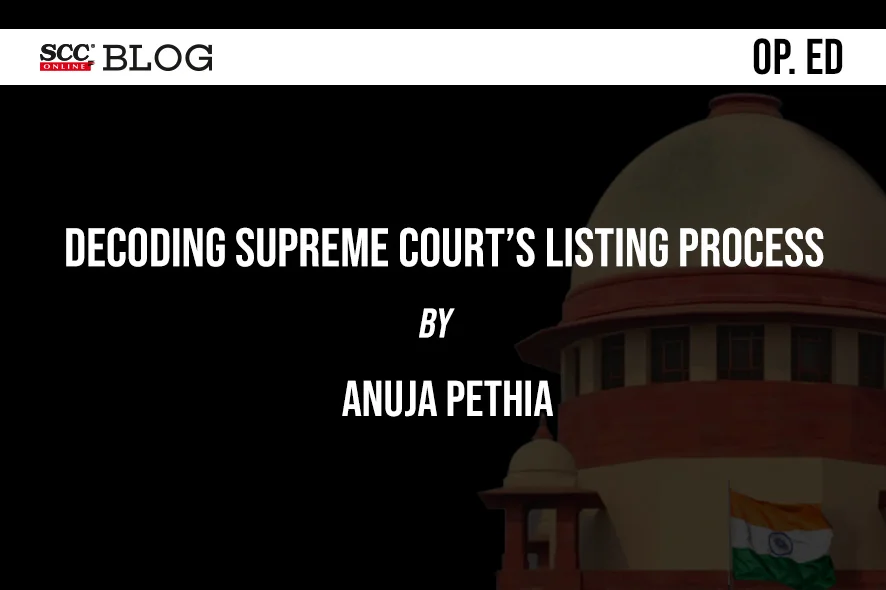My senior once told me that the challenge of being an Advocate-on-Record (AOR) is in getting your matters listed. I did not understand her at that time. I repeat these words to my junior counsel, who want to become an AOR.
The listing of the Teesta Atul Setalvad matter1 made me revisit the process of listing before the Supreme Court. The matter was filed on 1-7-2023 and listed before the Bench on the same day, in a matter of a few hours. Somehow, the Supreme Court website showed the matter to be still under defects till 6-7-2023. Screenshot below:

Now, at the outset, let me say that this article is not a comment on the merits of the order or the case, but merely an attempt to explain the difficult and uncertain path of navigating the Supreme Court Registry. I also acknowledge that the Registry may have its own constraints and issues and I am in no way critiquing the Registry, though, I will be dishonest if I do not express my frustration at getting matters cleared and listed sometimes.
With the disclaimers out of the way, let us understand what happens once a special leave petition (SLP) is given at the filing counter. This is my broad understanding of the process of listing without going into the specific requirements of a criminal or civil SLP or original suit or civil appeal, etc. or methods of urgent listing, etc. For the sake of brevity, I am also not discussing e-filing in the present article.
(a) The procedure of filing and listing before the Supreme Court is governed by the Supreme Court Rules, 2013.2
(b) Filing.— When an SLP is ready to be filed, the AOR or his registered clerk files it at the filing counter. Any other advocate can also file an SLP, provided he has his/her ID card and a letter authorising him or her to do so from the AOR.
(c) The filing counter is located opposite UCO Bank in the Supreme Court premises. At the counter, a dealing assistant (DA) takes your SLP and stamps it with the date of filing.
(d) The DA enters basic details on the computer. A basic check of the Vakalatnama and affidavit is done at this stage. Your SLP is hereby allocated a diary number — such as “Diary No. 1234 of 2023”.
(e) This SLP then goes to a scrutiny assistant (SA). The SA checks whether the SLP is in proper format and whether it prescribes to the Supreme Court Rules, 2013. The scrutiny assistant:
-
Checks that the court fee is proper.
-
Puts the case into a subject category.
-
Checks whether your case is within limitation.
-
Enters all the “defects” on his computer. A list of some common defects can be found here: <https://main.sci.gov.in/default-list>.
(f) These defects have to be removed by the AOR within 28 days by refiling of the SLP. Details of the defects that are notified can be seen on the “case status” tab on the Supreme Court website.

(g) If the defects are not removed within 28 days, an application seeking condonation of delay in refiling has to be filed along with the SLP.
(h) Verification of the case. — Once the defects are removed, the SA sends the SLP to the branch officer (BO). This process is called verification.
(i) At this stage, the BO scrutinises whether the case is in order and prepares an office report which also states whether any other identical or similar case is pending before the Supreme Court. He also enters the section or provision of law which the SLP is concerned with.
(j) The Registry checks if a caveat has been filed. The AOR has to serve the caveator and give proof of service to the Registry, in order for the SLP to be considered defect free.
(k) Registration of the SLP. —Once the Branch Officer is satisfied that all defects are removed and that the SLP is in order, he registers the case i.e. he enters the details of the SLP on his computer.
(l) If your SLP or civil appeal or criminal appeal is within the period of limitation, then the diary number is converted to SLP number or Civil Appeal Number at this stage. For e.g. SLP (Civil) No. 2345 of 2023 or Civil Appeal No. 2345 of 2023.
(m) Scanning. — After registration, a digital scan of the SLP is made. (Now, AORs are required to e-mail a soft copy of the SLP to the Registry. Thus, I am not sure whether the Registry scans the SLP or not, since AORs send them a defect free scanned copy.) The latest Notification3 for sending a soft copy of the SLP is Circular F. No. 10/Judl.2020, dated 27-7-2020.
(n) Listing.— A defect free SLP is listed by the listing branch typically within 1 week.
(o) Office report.— A fresh matter is typically listed on a Monday or a Friday (called miscellaneous days) before the Bench along with the office report.
If you want to learn more about the procedure of filing before the Supreme Court, this is a very good resource you can refer to, Supreme Court of India, Handbook on Practice and Procedure and Office Procedure.4
†Advocate-on-Record. LLM (cum laude), International Crime and Justice from Research Institute and Universitá Degli Studi di Torino, Italy and BA LLB (Hons.), National Law Institute University, India. Author can be reached at anuja@pethiashergill.com.
1.Teesta Atul Setalvad v. State of Gujarat, 2023 SCC OnLine SC 759.
3. Supreme Court of India, Circular F. No. 10/Judl.2020, dated 27-7-2020, <https://main.sci.gov.in/pdf/LU/27072020_124229.pdf> and <https://main.sci.gov.in/pdf/Notice/27062023_113322.pdf>.
4. Supreme Court of India, Handbook on Practice and Procedure and Office Procedure, available at <https://main.sci.gov.in/pdf/LU/ppop2017.pdf>.







